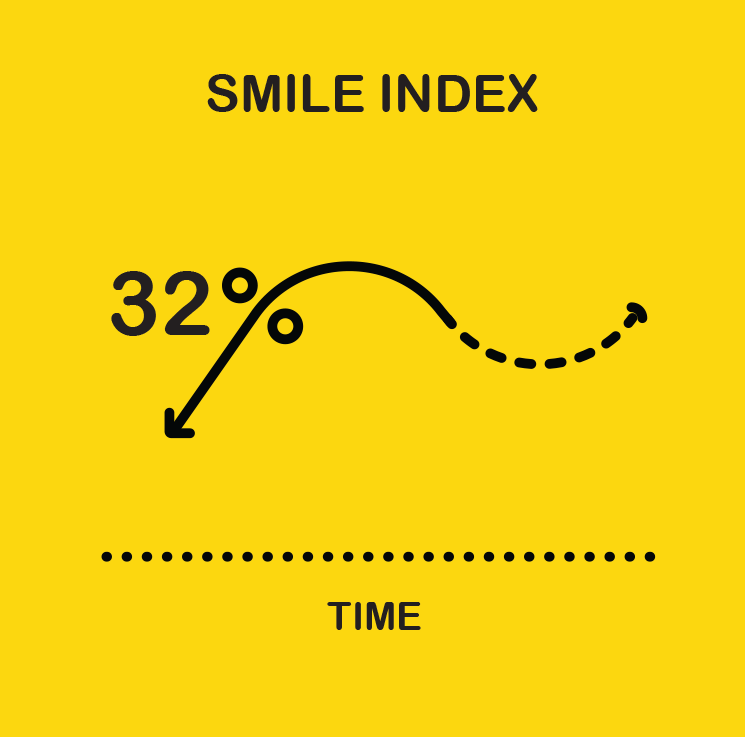
Amid COVID-19 Crisis, Smiles Drop 32%

Max Kalehoff
During a sustained global crisis, people go through a sequence of psychological stages, like ensuring their safety and security, then processing the meaning of the situation, and then embracing and adapting to a new normal.
Now is when all consumers are deciding what is your relevance, your role, and your very existence in their new normal going forward.
What is the new normal for brand advertisers? Nobody knows, though one thing is clear: People are smiling less, and they are slightly more distracted.
According to our analysis of video ad viewing experiences in the U.S., people are showing 32% fewer happy emotions, and a 2.9% drop in attention. Other emotions like disgust, confusion, contempt or surprise are not impacted thus far.
Our analysis compared the period of Feb. 25, 2020 (when the CDC first announced the Coronavirus outbreak would hit the U.S.) through Apr. 1, 2020, versus the same period year-ago. We used Realeyes’ emotion detection technology, which uses front-facing cameras, machine learning and opt-in audience to passively measure viewing of video advertisements. The emotion study included 58,000 comparable video views.
When it comes to emotional response to video ads, COVID-19 is selective in impacting norms across industries. The total decline in smiles was driven mostly by video ads from industries like Airlines, Hotels & Travel (-35%) as well as Electronic and Gadgets brands (-60%). Video ads from industries like Food & Confectionary, Business and Finance, Home Supplies and Healthy Living did not show any significant change so far.

Key Takeaways for Brand Advertisers Amidst COVID-19
Advertising Must Be Emotionally Intelligent: Consumers are less inclined to react happily to advertising from industries that are off limits for safety concerns, or which are nonessential or luxurious. That’s not to say such brands should stop advertising. Rather, they should recognize new barriers to inducing happy response, and should adjust goals and strategies accordingly. As our recent analysis of the auto industry’s first COVID-19 ads revealed, consumers are extremely receptive to brand advertising done the right way. Right now, that means emphasizing safety, comfort, stability and endurance, while avoiding product pitches for speeds and feeds.
Defer To Brand Measures That Don’t Lie: Our new normal is epitomized by “quarantine,” “eyes on screens” and “camera on by default.” Our new normal also is defined by an indefinite state of unknown, and evolving consumer sentiment. This challenges the merits of focus groups, laboratory research settings and self-reported surveys, when people are less likely to convey accurately what they’re thinking or how they’re feeling. This is a critical time to invest in observational metrics and naturally occurring biometrics, that reveal more accurate, more comprehensive and more granular intelligence about brand resonance. As ad measurement pioneer Bill Harvey recently wrote, the “objective will be to validate the data against what the company knows its true sales to be.” That is why we stand behind the scale, precision and efficiency of emotion detection; it directly leads to better performance.
Double-Down On Investments That Drive Performance & Results: Marketing leaders are scrutinizing their investments, including their approaches to understanding consumers – as they should. During a global crisis and economic uncertainty, every dollar of brand investment should work harder, both to sustain and grow to. Marketers should defer to investments that inform and enable performance and results. We believe that is why TV and digital video will do well. This channel is validated not only by history, but by strong and sustained attention and emotional response to the overall universe of video ads, especially in the current climate.
Conclusion: "I know that I know nothing"
That saying is derived from Plato's account of the Greek philosopher Socrates. And that truly is the only thing we really know. However, knowing how consumer sentiment norms are shifting in your category and your individual brand right now is the key to unlocking your creative, media and overall brand performance. Companies that stay close to their consumers and remain intelligently present will be the ones most likely to survive and thrive in the new normal of COVID-19.
